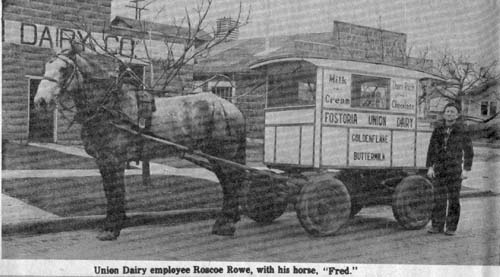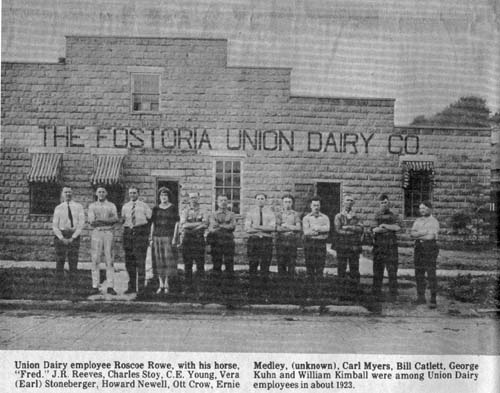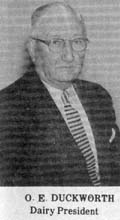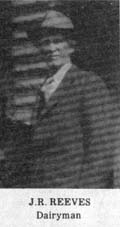May 17, 1979




Picture #1 – Union Dairy employee Roscoe Rowe, with his horse “Fred”
Picture #2 – Union Dairy employee Roscoe Rowe, with his horse, “Fred”, J.R. Reeves, Charles Stoy, C.E. Young, Vera (Earl) Stoneberger, Howard Newell, Ott Crow, Ernie Medley, (unknown), Carl Myers, Bill Catlett, George Kuhn and William Kimball were among Union Dairy employees in about 1923
Picture #3 – O.E. Duckworth – Dairy President
Picture #4 – J.R. Reeves – Dairyman
This is the story about milk…one of life’s precious commodities…dating back to the earliest history of man…and down to the past and present dairy business here in Fostoria.
Milk has been used by man from before the times of recorded history. As far back as 9,000 B.C., cow’s milk was mentioned, and the subject and it’s by products are mentioned 44 times in the Old Testament of the Bible. In Genesis 18:8 -“And he (Abraham) took butter, and milk, and the calf which he had dressed, and set it before them, (the three angels appearing as men) and he stood by them under the tree, and they did eat”. And in Judges 5:25 – “He (Sisera) asked water, and she (Jael) gave him milk; she brought forth butter in a lordly dish”. Old Sanskit writings 6,000 years old mention milk as one of the most essential foods of that time.
The oldest recorded illustration of cow’s being milked is a stone panel approximately four feet long, showing cows and their calves, with men milking into jars. The stone and said to be five to six thousand years old.
CHEESE MADE 4,000 B.C.
Excavations in Switzerland indicate that the people there made cheese as early as 4,000 B.C. Holland and Switzerland were the centers where the dairy industry was first developed in Europe.
History tells us that dairy cattle, goats and sheep were brought to the western hemisphere in the 16th century. The first importation of cattle to the colonies was 1611 to Jamestown, Va. and later to other settlements.
It was not until 1878 that milk was delivered in bottles, at which time it was introduced in New York City. The major problem was to find a satisfactory way to seal the bottles. Through the years there involved a variety of methods, many of which older readers will remember.
MILK SOLD UNSEALED
Before the advent of the glass bottle, milk was sold from unsealed containers the buyer furnishing his own container, the milk being dipped out in whatever quantity was purchased. Obviously, it was not a sanitary method for dispensing such a vitally needed food commodity.
Your editor remembers very vividly, as a young child of perhaps five, the milk wagon stopping at our house. Mother had a tin pail with a lid which held approximately one half gallon, which was our milk container for receiving the milk. The wagon had a foot-operated bell which announced their presence in the neighborhood. The purveyor to our house probably was either E.W. Kipka or O.E. Kipka, who both started in the dairy business in Fostoria in 1896, according to historical data assembled at Kaubisch Library.
According to the record, the first dairy establishment in Fostoria was the Morning Glory Creamery, located on South Main at Jones, in 1889. (The complete list of dairies and creameries that existed in Fostoria is contained in next week’s segment of this article).
GLASS BOTTLE INVENTED
Around 1900, the square glass milk bottle was developed, but did not reach popularity until the late 1940’s. In 1939 the “creamtop” bottle was introduced. The bulbous neck of the cream-top bottle served as a collector for the cream which came to the top. A specially shaped cream-spoon was made for removing the milk became standard the cream-top bottle became obsolete.
Bottle shapes and sized with a variety of closures were introduced through the years. Dr. Harvey D. Thatcher is credited with being the father of the glass milk bottle. Mike Owens of Libbey-Owens Glass Co., Toledo, developer of the Owens Vac Machine for making bottles, gave much credit to Thatcher and other pioneers in the development of bottles as they pertained to his automatic bottle-making machine.
Through the years a line of glass bottles, ranging in sizes of 1/4 pint, 1/2 pint, one pint, one quart, 1/2 gallon size in use today.
In approximately 1950 the first waxcoated paper carton milk containers started to make their appearance. Today, they are by far the most largely used medium for packaging milk.
CONDENSED MILK
Gail Borden, later to become known worldwide because of his development of condensed milk, earned the title of “Father of the Modern Dairy Industry”. It was 1853 when he invented condensed milk, a process by which he removed nearly all of the water by heating it at low temperature in the vacuum.
Borden was very particular about the milk that farmers supplied him for his condensed milk plant. He demanded that the cows udders be washed in warm water before milking; no milk supplied from cows that had calved within twelve days; no milk from cows fed on turnips or preserved fodder. He layed the foundation for the entire dairy industry that was to follow.
The Borden Company and Eagle Brand condensed milk were made famous by Gail Bordon.
Older Fostorians and some not so old, will have many memories as they scan the list of local dairies and creameries contained with this article…your editor does.
First I remember most, but not all of those listed. I have no recollection of the Morning Glory Creamery, Jacob Hoffmaster, or O.D. Wells.
PERSONAL EXPERIENCE
Secondly, when I was a boy, around 1916, I worked very briefly for the two Kipkas, E.W. (Ed) and O.E. “Ott”. I rode with one of Ed’s drivers one winter during the horse-drawn wagon was cold…heated only by a kerosene heater. I would be nearly frozen when the route was finished and we reached his house on Elm Street (about where Lowell School is now). I helped Fred Fromley, a route-man for Ott Kipka for awhile one summer, which wasn’t so bad. His horse-drawn wagon was open in the back, where we stood on a wide step. Glass bottles were in vogue for both of my short adventures in milk peddling.
In 1919, three of Fostoria’s larger dairies and creameries started.
FOSTORIA UNION DAIRY
Fostoria Union Dairy was one of those staring in 1919. At first, Jack Reeves was the General Manager. Later, it was reorganized, with O.E. Duckworth becoming president and general manager, and Reeves secretary and treasurer. Duckworth came here from Cleveland where he worked for the Armour Co. Before joining the Union Dairy, Duckworth worked for Fostoria Creamery.
In addition to distributing their products local, and also made cheese for Kraft.
Fostorian John Pierce, whose father James was a buttermaker at Union Dairy, especially remembers the chocolate milk they made “Real milk chocolate in it”, says John. Your editor remembers their goldenflake butter-milk…real buttermilk from the butter churn…not artificial I would take our little tin bucket with the lied and get it filled for a nickel.
THE OLD MILKWAGON
The accompanying illustration shows a partial view of the building Union Dairy occupied on East North Street, where Danielak Electric is now, also one of their horse-drawn wagons, with Roscoe Rowe (father of Mrs. Albert Thornton). Rowe, having been a farmer, and acquainted with horse-care, took care of all of the horses at Union Dairy, besides being a route-man. Incidentally, the horse in the photo was “Fred”. Like most of the milk-route horses, he knew the route as well as the driver and could be trusted to stop at each customer’s house, and turn corners without direction.
Another of the accompanying illustrations was taken at Union Dairy in 1922 or 1923, when Reeves was General Manager.
Union Dairy continued in business until 1957, at which time it was sold to Dairy, Toledo.
Duckworth died in 1963 and Jack Reeves in 1956. Odessa Duckworth, sister of E.E. Duckworth, was the bookkeeper for Union Dairy from 1938 until the business was sold. She still resides in Fostoria with another sister.
Others who worked for Union Dairy at one time or another, in addition to those mentioned already, or in connection with the photo’ were: Charles Mock, “Shorty” Sruder, Ed Vitt, Larry Vitt, Myron Snyder, Bob Weeks, Bob Weeks Jr., Maurice Reeves, Bea Snyder, Paul Kintz, John Snyder, Paul Adams, Al Kaufman, Bill Catlet, Glenn Marshall, James A. Pierce, Charlie Pierce, Marion Fiendel, Joseph Magers, Agens O’Connor.